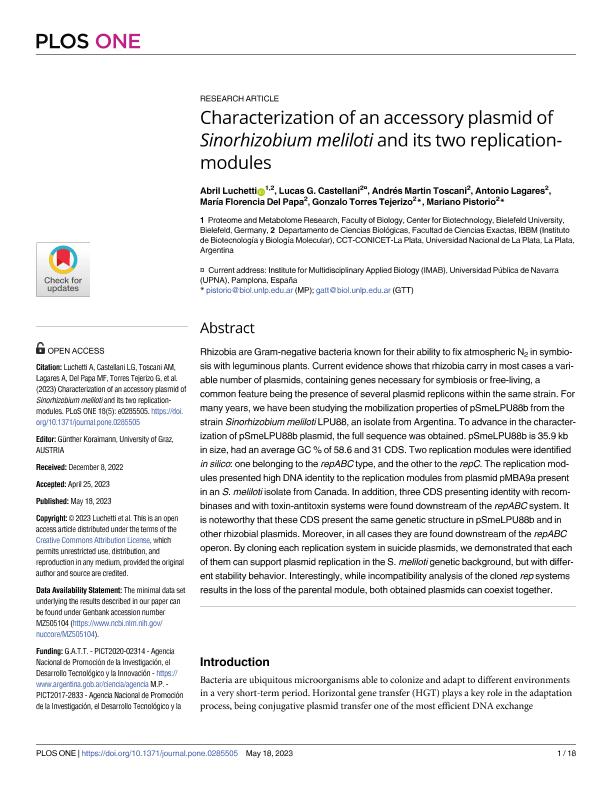Mostrar el registro sencillo del ítem
dc.contributor.author
Luchetti, Abril

dc.contributor.author
Castellani, Lucas Gabriel

dc.contributor.author
Toscani, Andrés Martin

dc.contributor.author
Lagares, Antonio

dc.contributor.author
del Papa, Maria Florencia

dc.contributor.author
Torres Tejerizo, Gonzalo Arturo

dc.contributor.author
Pistorio, Mariano

dc.date.available
2024-03-12T11:38:38Z
dc.date.issued
2023-05
dc.identifier.citation
Luchetti, Abril; Castellani, Lucas Gabriel; Toscani, Andrés Martin; Lagares, Antonio; del Papa, Maria Florencia; et al.; Characterization of an accessory plasmid of Sinorhizobium meliloti and its two replication-modules; Public Library of Science; Plos One; 18; 5; 5-2023; 1-18
dc.identifier.issn
1932-6203
dc.identifier.uri
http://hdl.handle.net/11336/230157
dc.description.abstract
Rhizobia are Gram-negative bacteria known for their ability to fix atmospheric N2 in symbiosis with leguminous plants. Current evidence shows that rhizobia carry in most cases a variable number of plasmids, containing genes necessary for symbiosis or free-living, a common feature being the presence of several plasmid replicons within the same strain. For many years, we have been studying the mobilization properties of pSmeLPU88b from the strain Sinorhizobium meliloti LPU88, an isolate from Argentina. To advance in the characterization of pSmeLPU88b plasmid, the full sequence was obtained. pSmeLPU88b is 35.9 kb in size, had an average GC % of 58.6 and 31 CDS. Two replication modules were identified in silico: one belonging to the repABC type, and the other to the repC. The replication modules presented high DNA identity to the replication modules from plasmid pMBA9a present in an S. meliloti isolate from Canada. In addition, three CDS presenting identity with recombinases and with toxin-antitoxin systems were found downstream of the repABC system. It is noteworthy that these CDS present the same genetic structure in pSmeLPU88b and in other rhizobial plasmids. Moreover, in all cases they are found downstream of the repABC operon. By cloning each replication system in suicide plasmids, we demonstrated that each of them can support plasmid replication in the S. meliloti genetic background, but with different stability behavior. Interestingly, while incompatibility analysis of the cloned rep systems results in the loss of the parental module, both obtained plasmids can coexist together.
dc.format
application/pdf
dc.language.iso
eng
dc.publisher
Public Library of Science

dc.rights
info:eu-repo/semantics/openAccess
dc.rights.uri
https://creativecommons.org/licenses/by/2.5/ar/
dc.subject
Rhizobia
dc.subject
Plasmid
dc.subject
Replication
dc.subject
Incompatibility
dc.subject.classification
Biología Celular, Microbiología

dc.subject.classification
Ciencias Biológicas

dc.subject.classification
CIENCIAS NATURALES Y EXACTAS

dc.title
Characterization of an accessory plasmid of Sinorhizobium meliloti and its two replication-modules
dc.type
info:eu-repo/semantics/article
dc.type
info:ar-repo/semantics/artículo
dc.type
info:eu-repo/semantics/publishedVersion
dc.date.updated
2024-03-11T12:06:25Z
dc.journal.volume
18
dc.journal.number
5
dc.journal.pagination
1-18
dc.journal.pais
Estados Unidos

dc.journal.ciudad
San Francisco
dc.description.fil
Fil: Luchetti, Abril. Consejo Nacional de Investigaciones Científicas y Técnicas. Centro Científico Tecnológico Conicet - La Plata. Instituto de Biotecnología y Biología Molecular. Universidad Nacional de La Plata. Facultad de Ciencias Exactas. Instituto de Biotecnología y Biología Molecular; Argentina. Universitat Bielefeld. Faculty Of Biology; . Universidad Nacional de La Plata. Facultad de Ciencias Exactas. Departamento de Ciencias Biológicas; Argentina
dc.description.fil
Fil: Castellani, Lucas Gabriel. Consejo Nacional de Investigaciones Científicas y Técnicas. Centro Científico Tecnológico Conicet - La Plata. Instituto de Biotecnología y Biología Molecular. Universidad Nacional de La Plata. Facultad de Ciencias Exactas. Instituto de Biotecnología y Biología Molecular; Argentina. Universidad Nacional de La Plata. Facultad de Ciencias Exactas. Departamento de Ciencias Biológicas; Argentina. Universidad Pública de Navarra; España
dc.description.fil
Fil: Toscani, Andrés Martin. Consejo Nacional de Investigaciones Científicas y Técnicas. Centro Científico Tecnológico Conicet - La Plata. Instituto de Biotecnología y Biología Molecular. Universidad Nacional de La Plata. Facultad de Ciencias Exactas. Instituto de Biotecnología y Biología Molecular; Argentina. Universidad Nacional de La Plata. Facultad de Ciencias Exactas. Departamento de Ciencias Biológicas; Argentina
dc.description.fil
Fil: Lagares, Antonio. Consejo Nacional de Investigaciones Científicas y Técnicas. Centro Científico Tecnológico Conicet - La Plata. Instituto de Biotecnología y Biología Molecular. Universidad Nacional de La Plata. Facultad de Ciencias Exactas. Instituto de Biotecnología y Biología Molecular; Argentina. Universidad Nacional de La Plata. Facultad de Ciencias Exactas. Departamento de Ciencias Biológicas; Argentina
dc.description.fil
Fil: del Papa, Maria Florencia. Consejo Nacional de Investigaciones Científicas y Técnicas. Centro Científico Tecnológico Conicet - La Plata. Instituto de Biotecnología y Biología Molecular. Universidad Nacional de La Plata. Facultad de Ciencias Exactas. Instituto de Biotecnología y Biología Molecular; Argentina. Universidad Nacional de La Plata. Facultad de Ciencias Exactas. Departamento de Ciencias Biológicas; Argentina
dc.description.fil
Fil: Torres Tejerizo, Gonzalo Arturo. Consejo Nacional de Investigaciones Científicas y Técnicas. Centro Científico Tecnológico Conicet - La Plata. Instituto de Biotecnología y Biología Molecular. Universidad Nacional de La Plata. Facultad de Ciencias Exactas. Instituto de Biotecnología y Biología Molecular; Argentina. Universidad Nacional de La Plata. Facultad de Ciencias Exactas. Departamento de Ciencias Biológicas; Argentina
dc.description.fil
Fil: Pistorio, Mariano. Consejo Nacional de Investigaciones Científicas y Técnicas. Centro Científico Tecnológico Conicet - La Plata. Instituto de Biotecnología y Biología Molecular. Universidad Nacional de La Plata. Facultad de Ciencias Exactas. Instituto de Biotecnología y Biología Molecular; Argentina. Universidad Nacional de La Plata. Facultad de Ciencias Exactas. Departamento de Ciencias Biológicas; Argentina
dc.journal.title
Plos One

dc.relation.alternativeid
info:eu-repo/semantics/altIdentifier/url/https://dx.plos.org/10.1371/journal.pone.0285505
dc.relation.alternativeid
info:eu-repo/semantics/altIdentifier/doi/http://dx.doi.org/10.1371/journal.pone.0285505
Archivos asociados
